 полная версия
полная версияThe True Story of the American Flag

John Henry Fow
The True Story of the American Flag

Fig. 8
FLAG CARRIED BY THE FIRST CITY TROOP OF PHILADELPHIA IN ESCORTINGWASHINGTON ACROSS THE JERSEYS ON HIS WAY TOTAKE COMMAND AT CAMBRIDGE
INTRODUCTION
I was induced to make this research by the late William H. Egle, Librarian of the State Library at Harrisburg, whose knowledge of the early history of Pennsylvania was of valuable assistance to me in preparing the data for a history of the country along the Delaware river prior to 1682 (yet unfinished). Mr. Egle agreed with me that the claim of Mr. Canby that Betsy Ross designed and made the first flag was legendary and without that foundation which is so necessary to uphold claims of this character. Statements of such a character, when allowed to go unrefuted, do harm to the history of any people, inasmuch as they encourage others to build “air castles” and purchase old portraits to be palmed off on others as our “grandfather” who “fit” in the Revolution, or our “grandmother” who carried supplies to the troops at Valley Forge.
History is the best incentive to make men love their country; it encourages that patriotism which never falters, even at the cannon’s mouth. The sight of a flag or the music of a band merely enthuses as long as one is in sight or the other can be heard; but history and its knowledge are lasting and a source of pride. So, therefore, let it be true in all its details, no matter who may fall from the high pedestals upon which they have been placed by vain-glorious descendants.
John H. Fow.THE AMERICAN FLAG
“It will probably never be known who designed our Union of Stars, the records of Congress being silent upon the subject, and there being no mention or suggestion of it in any of the voluminous correspondence or diaries of the time, public or private, which have been published.”—Rear-Admiral Preble.
So far as regards the adoption of the combination of stars and stripes, the same assertion can be safely made. As to the origin of each this research, it is hoped, will prove conclusively, first, that colored stripes representing a combination for a common purpose were used nearly two hundred years before the Declaration of Independence; second, that stars were used in the union of a flag in November, 1775, on a flag raised on a Massachusetts privateer commanded by Captain Manley (see Fig. 1), and that they were also used in the design of the book plate of the Washington family along with three stripes.
There can be no doubt that the stripes were made thirteen as a mere matter of sentiment to represent the colonies engaged in the Revolutionary struggle. As a matter of fact, the number thirteen appeared in a large number of instances during the Revolution, and was apparently used as an object lesson to remind the colonists that they were united in a common cause.
The colors of the stripes have no special meaning or significance, except that which anyone may apply who desires to make use of his imagination, or who may become sentimental upon the subject. Many have written and commented upon it; some have said that the red stripes mean courage, others war, daring, determination, and so on, and that the white stripes mean purity, peace, justice, or equity.
“Thy stars have lit the welkin dome,And all thy hues were born in heaven.”As a matter of fact, the idea of stripes in a flag to represent a combination for a common purpose originated in 1582 in the Netherlands, and symbolized the union of the Dutch Republic in its struggles against the power of Philip and the persecutions of Alva.
In a paper read before the New Jersey Historical Society by a Mr. Haven in January, 1872, he suggested “that the combination of our flag, the stars and stripes, were favored as a compliment to Washington, because they were upon the book plate of the General’s family.” He further stated “that the stars on the book plate were of Roman origin,” and in support quoted from Virgil “Redire ad astra,” meaning and inferring that a return to the stars meant a future home of peace and happiness for the human race, and that is what this nation would eventually become. Assertions and statements similar to the above may be quoted by the score, wherein reasons are given based upon theory and imagination as to the origin of the devices which compose our national banner.
The claim that has been made about Betsy Ross, who worked at upholstering and as a seamstress during the Revolution, who is said to have lived in a house either No. 80 or 89 Arch street, Philadelphia, now said to be No. 239 Arch street, as having some time in June, 1776, made and designed the first American flag as we now worship it, cannot be corroborated by historical research.
The claim is one of that legendary type that the Rabbins of old handed down for centuries, and which were believed to be true, until modern investigation proved their falsity, or like the imagination of artists who attempt to paint historical events without consulting details, historical, and geographical. The two most notorious in our history are Leutze’s painting of Washington crossing the Delaware, and Benjamin West’s painting of William Penn treating with the Indians. As to the first, I write from authority, having been designated to represent the Legislature of Pennsylvania as one of a committee of three to act in conjunction with the Trenton Battle Monument Committee to select an historical subject for the medallion to be placed upon one of the four sides of a monument, erected at Trenton, to represent Pennsylvania’s part in that memorable event, we chose as the subject “Washington Crossing the Delaware,” and the result of our labor, and investigation in conjunction with the Monument Committee can be seen to-day on the west side of the monument. The bronze tablet placed there by the Commonwealth of Pennsylvania truthfully delineates that notable event. The late General Stryker, of New Jersey, aided us, and furnished us books, and documents to obtain part of the data. The tablet represents a small rowboat, with General Knox sitting in the bow of the boat, and Washington in the stern, the man rowing the boat was a Mr. Cadwalader. He lived at McKonkey’s Ferry, on the Pennsylvania side of the river. Leutze in his painting has Washington standing alongside of a horse in a large scow, such as were used in those days on the upper Delaware to take produce to the Philadelphia markets. A number of others are in the same boat, one holding aloft a flag containing a blue union with thirteen white stars—a flag that did not come into existence until six months after the battle was fought.

FLAG CARRIED IN THE REVOLUTION BY COUNT PULASKI’S LEGION
As to West’s picture, one need only look at it, and then read the facts as related in any history of Pennsylvania, and it will be found how historically untrue it is. One instance alone would be sufficient; that is, in the painting, the vessel in which Penn came over is anchored out in the river, when, as a matter of fact, she never came up to Philadelphia. She was quarantined below Chester because of the smallpox, and Penn was rowed up the river from Chester in a small boat, and landed near the residence of the Swensons, two Swedes, who lived at Wicaco, and from whom he bought the land comprising old Philadelphia. Again, the elm tree is in full leaf, yet the “pow-wow” that Penn held with the Indians took place in November, and elm trees do not have leaves on them in this latitude in November. But why digress from the subject about which I started to write, merely to show that artists and those seeking for family distinction are not to be relied upon as truthful delineators of history.
The Ross claim is based upon the assertions set forth in a paper read in 1870 by Mr. William Canby before the members of the Historical Society of Pennsylvania. It was claimed in the paper or essay that from traditions existing in the Ross family, Betsy Ross, the grandmother of Mr. Canby on his mother’s side, was the maker and designer of the first American flag, and that she lived on Arch street. A research shows that a Betsy Ross did live on Arch street; but the exact location is doubtful, and that her maiden name was Griscom. She was married three times, first to John Ross, second to Ashburn, and lastly to John Claypoole.
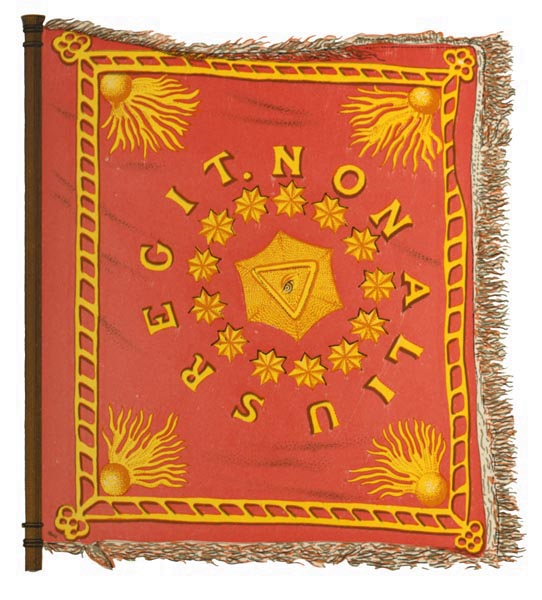
FLAG CARRIED IN THE REVOLUTION BY COUNT PULASKI’S LEGION
It was asserted in the paper read that a committee of Congress, along with General Washington, in June, 1776, called at her house, and engaged her to make a flag from a rough drawing, which, not suiting her, was at her suggestion, redrawn by Washington. From other traditional resources it was also claimed, that Mrs. Ross changed the stars from six-pointed to five-pointed. The whole claim is based upon tales told from memory by relatives, no other proofs have ever been found, and a careful and thorough research fails to discover any. In 1878 a pamphlet was issued from the printing office of the State printer at Harrisburg, Pennsylvania, written by a Mr. Reigart, based upon the above claim, and calling Mrs. Ross “the immortal heroine that originated the first flag of the Union.” The book had an alleged portrait of Betsy Ross making the first flag; but it was afterwards discovered that it was really the portrait of an old Quaker lady who was living in Lancaster at the time the book was written. The book was so unreliable that it made the Ross claim appear ridiculous in the eyes of the public.
If Mrs. Ross made a flag in an Arch street house, as claimed, it was made after a design that had been conceived and born somewhere else, and her contribution was no more than her labor in sewing on some stars, the same labor that is given by any girl or woman who works in a flag manufactory. Even according to the paper which was read before the Society in 1870 it is admitted that a design made by someone else was taken to her, but that she made certain changes in it. Now, that is all there is in the Betsy Ross claim; yet the growing youths of the nation are being misled and taught an historical untruth when it is asserted that Mrs. Ross designed, originated and made the first American flag, and a lithograph has been issued showing that historical untruth, which has not as good a foundation, in fact, as the two paintings to which I have referred, because the events sought to be depicted in those two cases did happen. All the sentiment exhibited over the Betsy Ross story is lost upon those who have looked the matter up, and are conversant with the history and growth of our national emblem, which I will now take up. Those seeking for more elaborate details are referred to Bancroft’s History of the United States; Lossing’s Field Book of the Revolution; Philadelphia Times, April 6, 1877; The American, The Colonial and the Pennsylvania Archives; Journals of Congress, Vols. 1 and 2; Preble’s History of the Flag; Cooper’s Naval History; Life of John Adams; Hamilton and Sarmiento’s Histories of our Flag; Sparks’ and Washington Irving’s Lives of Washington; Washington’s own letters, diaries and other writings, and William Cullen Bryant’s History of the United States, in which pages 420 and 421 of the third volume he devotes to a history of the flag, but nowhere does he mention the Ross claim. He evidently, like myself, could not find any authority for it, yet his history was published in 1879—nine years after the Ross claim was made. There are many other authorities, but not one of them gives her the credit claimed, and all of them except those written since the claim was made, leaving out the Bryant history, do not even mention her name.
A claim similar to the one made by Mr. Canby on behalf of Betsy Ross, was made by a woman named Elizabeth Montgomery, daughter of Captain Montgomery, of the armed Brig Nancy. She claimed that a flag, “stars and stripes,” was made early in July, 1776, by a young man on her father’s brig while it was in port at St. Thomas; see “Reminiscences of Wilmington, ancient and new,” printed in 1851, on pages 176 to 179; but her claim it proved to be absolutely false, as a reference to the American Archives, vol. vi, page 1132, fourth series, will show that the Brig Nancy, Captain Montgomery, was destroyed at Cape May, June 29, 1776, to keep her from being captured by the British.
At the outbreak of our Revolutionary struggle the different colonies had flags of their own design, which, if grouped together, would have reminded one of Joseph’s coat, embellished with Latin and other mottoes. At the battle of Bunker Hill the Americans fought without a flag, although Botta in his history of the American Revolution says that there was one with the words “An Appeal to Heaven” on one side, and the Latin inscription “Qui transtulit sustinet” upon the other (see Fig. 2). In Lossing’s field book of the American Revolution, Vol. 1, page 541, he states that an old lady named Manning informed him that the Americans did have a flag at the battle, of which the field was blue and the union white, having in it the Red Cross of St. George and a green pine tree (see Fig. 3); but this cannot be considered an authority any more than Trumbull’s picture of the Battle in the Rotunda of the capital at Washington. He depicts the American flag carried in that battle as something which no one ever saw or even heard of, to wit: a red flag with a white union, having in it a green pine tree (see Fig. 4).
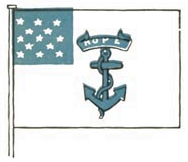
Fig. 1
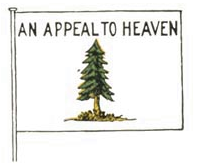
Fig. 2

Fig. 3
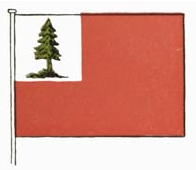
Fig. 4
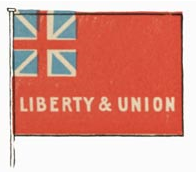
Fig. 5
Frothingham in his history of the siege of Boston says that there was a flag over Prescott’s redoubt having upon it the words “Come if you dare;” but there is no authority given for the statement. As a matter of fact, it might have been, for at that period flags were used as ensigns, with different sentences upon them, such as “Liberty and Union,” “An Appeal to Heaven,” “Liberty or Death,” “An Appeal to God.” Several such flags were captured by the British and mentioned in the English journals of that period (see Figs. 5, 13, 14 and 15). Also in Powell’s picture of the battle of Lake Erie in the national capital Perry is seen in a boat with a flag of thirteen stripes and thirteen stars; yet when the battle was fought the American flag consisted of fifteen stripes and fifteen stars, and had been so constituted since 1794, because under an act of Congress there was to be a stripe and a star added for the two States admitted after the thirteen colonies became States, to wit: Kentucky and Vermont. So Congress on the 13th day of January, 1794, passed an act fixing the number of stripes and stars at fifteen, and such was the Star-Spangled Banner that Key saw at Fort McHenry in the “dim morning’s light” when he wrote the words of our National Hymn, as a matter of fact, the war of 1812 was fought under a flag of fifteen stripes and fifteen stars. In 1878, at a fair in Boston, the flag of the United States brig “Enterprise,” that fought the English brig “Boxer” on September 15, 1813, was exhibited. It had fifteen stripes and fifteen stars. It belongs to a Mr. Quincy, of Portland, Maine. It was not until the 4th day of April, 1818, that Congress passed the act fixing the number of stripes, alternating red and white, at thirteen, to represent the thirteen original colonies, and a blue union with a white star for every State then in the Federal Union, and for those that would be admitted an extra star to be added on the 4th day of July after the admission of the State. Now, by a late act, the State is not admitted until the 4th day of July after the passage of the act admitting her to statehood. The act reads as follows:
“An Act to establish the flag of the United States. Sec. 1. Be it enacted, etc., that from and after the fourth day of July next the flag of the United States be thirteen stripes alternate red and white; that the union have twenty stars white in a blue field.
“Sec. 2. And be it further enacted that, on the admission of every new State into the Union, one star be added to the union of the flag; and that such addition shall take effect on the fourth of July next succeeding such admission.
“Approved April 4, 1818.”
The use of stars by the Colonies on their flags was first suggested by a little piece of poetry in a newspaper called the “Massachusetts Spy,” published in Boston on March the 10th, 1774. It was as follows:
“A ray of bright gloryNow beams from afar;The American EnsignNow sparkles a star.”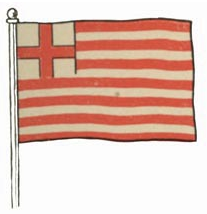
Fig. 6
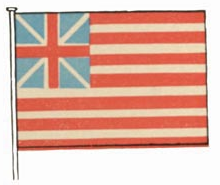
Fig. 7
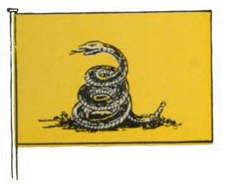
Fig. 10
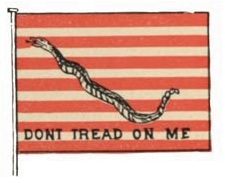
Fig. 11
This piece of poetry was the cause of a flag being made in 1775 by a patriotic vessel owner of Massachusetts having thirteen white stars on it in a blue union, the body of the flag being white, with an anchor upon it having over the top the word “HOPE” (see Fig. 1), already mentioned. It was hoisted on the armed schooner Lee, Captain John Manley (see also Rhode Island Colonial Records, Vol. X, p. 14. A similar flag is now in the office of the Secretary of State. It was carried by a Rhode Island regiment during the Revolution). Either this or the stars on the Washington book plate, in the absence of any record, may be taken as reasons for the adoption of the stars in the union in place of the crosses of St. Andrew and St. George. I have also referred to the claim that the combination of the stars and stripes was probably adopted out of love and respect for Washington. If this claim is true, then we would have, according to the Ross claim the spectacle of Washington complimenting and honoring himself, when, as a matter of fact, his whole life disproves such conduct on his part. Now, let us see if this argument as to the origin of the combination is born out by facts. We find in a book printed in London in 1704 by J. Beaumont that the English East India Company had a flag of thirteen red and white stripes alternating (see Fig. 6) the same as ours, only it had the red cross of St. George in a white union. In 1705 they reduced the stripes to ten; but in another work on ship-building, published in 1705, by Carl Allard in Amsterdam, we find that he fixes the number of stripes at nine. Also in a book published by Le Haye in 1737 we find that the number of striped flags in existence in Europe were as follows: Bremen, nine stripes, red and white, with a union of four squares, same colors; Rotterdam, eleven stripes, red and green; North Holland, thirteen stripes, red and yellow; East India Company, thirteen stripes, red and white, with a white union and St. George Cross, already mentioned. But no matter as to the number of stripes, it is thus conclusively shown that thirteen red and white stripes were in use seventy years before they were adopted by the American Colonies. In October, 1775, while the English troops were besieged in Boston by the troops under Washington, it became apparent that we should have some sort of a flag to represent the Colonies in the aggregate, and show thereby that they were acting in concert; so a committee was appointed, of which Benjamin Franklin was the chairman. It was determined that the flag should be called the Grand Union Flag, and that it should have thirteen red and white stripes alternating to represent the thirteen Colonies, and the crosses of St. George and St. Andrew in the union to attest their loyalty to the Crown (see Fig. 7), as at that period national sovereignty was not contemplated. The quarrel as claimed was simply over the right to be represented in the taxing body of the British nation. Preble in his history of the flag says, on page 225, as to the stripes being used at the instance of Washington:
“Without further seeking for the origin for the stripes upon our flag, it is possible that the stripes on his own escutcheon suggested them. They were also on the flag of the Philadelphia Light-horse that escorted him on the road to Cambridge from Philadelphia as far as New York in 1775” (see Fig. 8). This latter flag is in Philadelphia, and is the property of the Philadelphia First City Troop. The Philadelphia Sunday Dispatch in 1871 gave a very interesting history of it. Messrs. Lynch and Harrison were Franklin’s colleagues on the committee. In November, 1775, they met at Cambridge in Washington’s headquarters, and, after carefully considering all the facts, adopted the Grand Union Flag above described. “The Union Jack” was called “the king’s colors” because of the crosses to which allusion has been made. The first flag that was made, there being no record of the name of the maker, was hoisted over Washington’s headquarters at Cambridge on the second day of January, 1776. In a letter to Mr. Reed, dated the 4th day of January, Washington wrote that “the saluting of this flag by cannon and musketry fire gave rise to a ridiculous idea on the part of the British in Boston, who, that day having received copies of the king’s speech to Parliament, supposed that the Colonial troops had also received copies, and that the salute was in honor of the king, and that the rebellious Colonists had submitted.” So, first, as early as the 2d day of January, 1776, the flag we all love except the blue union and white stars, was in existence. Second. We have the names of the men who designed it. Third. That it was raised at Cambridge. Fourth. The reasons why the combination was adopted; and fifth, that its first raising was an official act.... So therefore we now have to deal only with the change of the union from the crosses to the stars; and this is best arrived at by following the history of the navy of that time:
The navy of the Colonies in 1775 consisted of armed vessels, either maintained by private enterprise, by the Councils, Boards of War, or Navy Boards of the different colonies, the general Congress making no provisions for the establishment of a colonial navy until October 13, 1775, when, after a general debate based upon the report of a committee, the following resolution was adopted (see Journal of Congress, Vol. 1, p. 204):
“Resolved, That a swift sailing vessel to carry the carriage guns and a proportionate number of swivels, with eighty men, be fitted with all possible dispatch for a cruise of three months.”
After discussion it was further
“Resolved, That another vessel be fitted for the same purpose, and that a marine committee, consisting of Messrs. Dean, Langdon and Gadsden, report their opinion of a proper vessel and also an estimate of the expense.”
Two days later, October 20, 1775, Washington wrote a letter suggesting to the Congress that a flag be adopted, so that “the vessels may know one another.” This idea was a flag with a white ground, a tree in the middle, and the sentence: “An Appeal to Heaven” on it (see Fig. 2, already mentioned).

